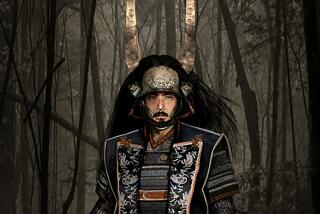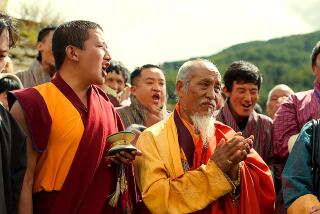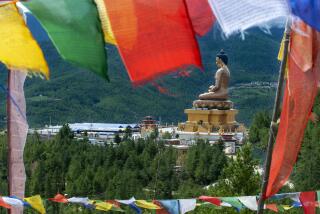Bhutan’s Culture Revealed in Rich Textiles
- Share via
If there is a real place that might correspond to the fictional Shangri-La, it’s surely the little nation of Bhutan. Wedged landlocked high in the Himalayas between India and Tibet, it’s so obscure it draws a blank on the map of the mind. Well, Shangri-La is supposed to be a remote and secret land.
Now, however, this little agrarian, Buddhist kingdom that houses less than three-quarters of a million souls in a country about the size of Switzerland is sticking its toe into the global world and getting some notice. This is not, thank goodness, because it’s erupted in civil strife, gone nuclear or wishes to become a tourist attraction. The country guards its ecology carefully and permits only about 3,500 visitors annually. The current reason why Bhutan has appeared on the map is because the Bhutanese make great textiles. Experts regard them as the country’s preeminent art form. What a nice, reassuring thing to get famous for.
The evidence is on view at the Los Angeles County Museum of Art in “From the Land of the Thunder Dragon: Textile Arts of Bhutan.” The traveling exhibition of about 60 examples was inaugurated by Bhutan’s monarch Her Majesty Queen Ashi Sangay Choden Wangchuck, organized by the Peabody Essex Museum in Salem, Mass., and it comes with a hefty catalog.
In traditional societies like Bhutan’s, cloth almost literally forms the fabric of the culture, it symbolizes humankind’s evolution from a race of hunter-gatherers dressed in animal pelts to civilized people festooned in silk. For centuries weavers lavished endless care on cloth. It substituted for skins not only in giving warmth but also in defining status. Anybody who thinks this symbolic function no longer applies is reminded of the current move to make kids wear uniforms to school so they’ll stop killing each other to get fancy threads.
Bhutanese textiles continue the high value placed on them as everything from marks of rank to marriage and export goods. Generically they resemble Asian textiles and costumes, but with those local variations that make us know we’re not in Beijing anymore, Toto. Cloths have the straightforwardness of folk fabrics but their geometric, animal and other motifs are elaborated and refined down to microscopic detail. Dyes tend to be rich and sonorous, although one vintage tunic is so subtly tinted and patterned that the sturdy fabric appears delicate.
The single most spectacular costume is one worn for Bhutan’s ritual Black Hat Dance. Rarely seen outside the country, such costumes have a distinctive, heavy triangular shape and cloths teeming with dragons and guardian figures. Structurally, clothing designs remain simple, allowing draping and surface patterning to carry the expressive drama of the garment. Particularly striking is a black woolen tunic with applique patterning in red and gray and a pair of embroidered ceremonial boots with upturned toes that look to us like something straight from Shangri-La.
As Bhutan tests the winds of the developed world, its weavers are trying out new looms and nontraditional dyes--so far without apparent ill effect. And so far there has been little tendency to widespread adoption of Western modes of dress that some experts believe to mark the unraveling of any ancestral culture.
* Los Angeles County Museum of Art, 5905 Wilshire Blvd., through May 5, closed Mondays, (213) 857-6000.
More to Read
The biggest entertainment stories
Get our big stories about Hollywood, film, television, music, arts, culture and more right in your inbox as soon as they publish.
You may occasionally receive promotional content from the Los Angeles Times.










